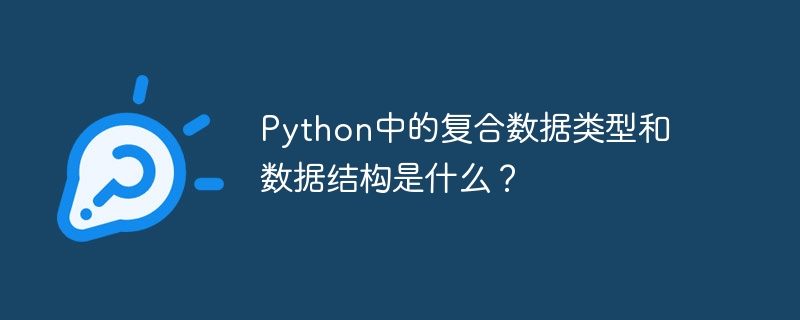Python中的複合資料型別和資料結構是什麼?
- PHPz轉載
- 2023-08-19 16:45:151439瀏覽

在本文中,我們將解釋Python中的複合資料型別和資料結構。
到目前為止,變數只能儲存一個值。如果我們希望保存許多相關的值呢?
我們可以簡單地為每個變數建立不同的變數。
但是如果我們不知道會有多少個值呢?
如果我們希望在循環中使用這些值,該怎麼辦?
複合資料結構是可以儲存大量值的資料型別。
在Python中,有各種類型的複合資料結構。
我們將主要集中在清單。
最後,我們將快速了解Sets, Tuples, and Dictionaries。
列表
在Python中,列表是一個有序的序列,可以容納多種物件類型,如整數、字元或浮點數。在其他程式語言中,列表相當於數組。
列表只是由用逗號分隔並用方括號[]括起來的值組成的列表。
inputList = [“hello”, “tutorialspoint”, 1, 3.5, “python”]
列表操作
有許多操作可以對清單進行,以便從中建立表達式。
1)使用len()函數取得列表的大小
#使用len()函數取得列表的長度/大小(len()方法傳回物件中的項目數。當物件是列表時,len()函數傳回清單中的項目數),並創建一個變數來儲存它。
範例
# input list
lst = ["Hello", "TutorialsPoint", 78, "Hi", "Everyone"]
# getting list length
listLength = len(lst)
# Printing the size of a list
print("Size of a List = ", listLength)
輸出
('Size of a List = ', 5)
使用索引存取清單元素
術語 "indexing" 指的是根據元素在可迭代物件中的位置來取得元素。
索引從0開始。序列中的第一個元素以索引0表示。
負索引從-1開始。序列中的最後一個元素由索引-1表示。
範例
# input list
inputList =[1, 4, 8, 6, 2]
# accessing the list element at index 2 using positive indexing
print("Element at index 2:", inputList[2])
# accessing the last element in list using negative indexing
print("last element of an input list:", inputList[-1])
輸出
('Element at index 2:', 8)
('last element of an input list:', 2)
注意
當我們嘗試使用不存在或過大的索引時,會拋出一個 IndexError
迭代列表
使用For迴圈
以下程式使用for迴圈列印所有清單元素:
# input list
inputList = [10, 20, 30, 40, 50]
print("Input list elements:")
# traversing through all elements of the list using for loop
for element in inputList:
# printing each element of the list
print(element)
輸出
Input list elements: 10 20 30 40 50
清單項目上的重複運算子(*)
Python List還包括*運算符,它允許你建立一個新的列表,其中的元素重複指定的次數。
範例
以下程式使用*運算子重複給定次數的清單-
# input list inputList = [5, 6, 7] # Repeating the input list 2 times using the * operator print(inputList * 2)
輸出
[5, 6, 7, 5, 6, 7]
在這裡,我們使用*運算子將隨機值列表乘以兩次,這樣輸出就是給定列表重複兩次。
Python中的元組
元組是一個不可變的序列資料類型,可以包含不同資料類型的元素。元組只是由逗號分隔的Python物件的集合。由於元組是靜態的,所以它們比列表更快。
列表和元組的語法有些不同。列表以方括號 [] 表示,而元組則以括號 () 表示。
元組切片
我們可以使用元組切片。它與我們使用字串和列表的方式類似。元組切片用於取得各種項。我們也使用切片運算子來執行元組切片。切片運算子可以用以下語法表示
[start:stop:step]
Example
的中文翻譯為:範例
# Input tuple
givenTuple = ("Welcome", "this", "is", "TutorialsPoint", "Website", 10)
# Slicing with start and stop values(indices)
print('Tuple slicing from index 1 to index 6 :', givenTuple[1:6])
# Slicing with only stop values(indices)
print("Tuple slicing till index 7: ", givenTuple[:7])
輸出
Tuple slicing from index 1 to index 6 : ('this', 'is', 'TutorialsPoint', 'Website', 10)
Tuple slicing till index 7: ('Welcome', 'this', 'is', 'TutorialsPoint', 'Website', 10)
使用索引存取元組元素
與清單一樣,元組也使用索引來存取其元素。唯一的區別是元組是不可變的(不能被改變),而列表是可變的。
範例
的中文翻譯為:範例
## input tuple
inputTuple = (1, 4, 8, 6, 2)
# accessing the tuple element at index 2 using positive indexing
print("Element at index 2:", inputTuple[2])
# accessing the last element in tuple using negative indexing
print("last element of an input tuple:", inputTuple[-1])
輸出
('Element at index 2:', 8)
('last element of an input tuple:', 2)
注意
當我們嘗試使用不存在或過大的索引時,會拋出一個 IndexError
Python中的字典
使用dict.keys()方法從字典中取得所有鍵的列表
使用keys() 函數將其應用於輸入的字典,然後使用list() 函數(將序列/可迭代物件轉換為列表)將結果轉換為列表,以列印字典的所有鍵。
Example
的中文翻譯為:範例
# input dictionary
demoDictionary = {10: 'TutorialsPoint', 12: 'Python', 14: 'Codes'}
# Printing the list of keys of a dictionary using the keys() function
# list() methods convert an iterable into a list
print(list(demoDictionary.keys()))
輸出
[10, 12, 14]
結論
在這篇文章中,我們學習了複合資料型別和資料結構,以及它們的一些例子。
以上是Python中的複合資料型別和資料結構是什麼?的詳細內容。更多資訊請關注PHP中文網其他相關文章!

